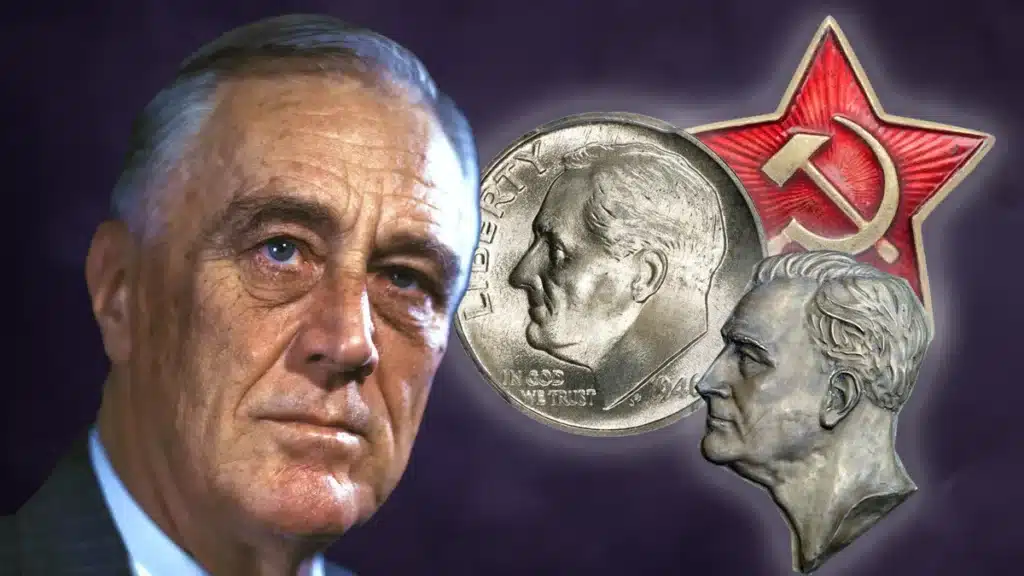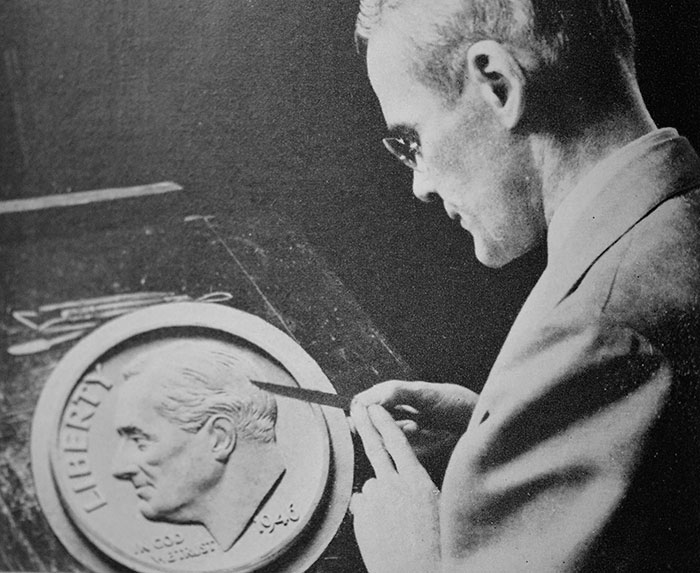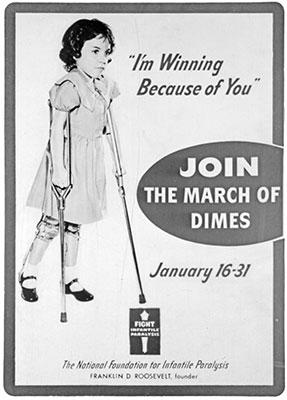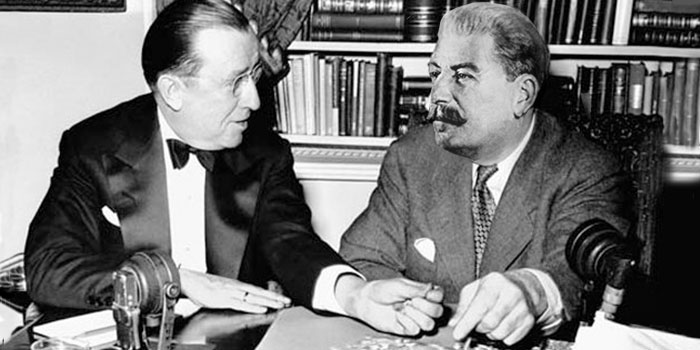
By David Thomason Alexander for CoinWeek …..
Most circulating United States coins have received their share of negative press when first issued. This includes the beloved Roosevelt dime.
The first 1793 cents were denounced for their Chain reverse, adapted from the earlier Fugio cent but held to be a poorly chosen symbol with which to back up the Liberty head obverse. John Reich’s buxom Liberty on the 1807 half dollar was sneered at as a likeness of the artist’s “fat German mistress.”
It is scarcely necessary to go back that far in history for other examples of such popular outcries, which in virtually every case have not been based on fact. The great strength of rumor, even before the internet, has always been the ease with which preposterous stories can be launched and the difficulty in silencing them. The stories are almost always so much more fun! The first 1916 Standing Liberty quarter allegedly received a storm of criticism because designer Hermon McNeil left Liberty’s breast bare.
And some of the loudest denunciations have been based on historical memory rather than fact, such as Southern objections to the placing of Abraham Lincoln’s bust on the cent in 1909 – the “final step in transforming America into a monarchy!” as some newspapers put it at the time.
So it was upon the death of President Franklin Delano Roosevelt at his “Little White House” in Warm Springs, Georgia, on April 12, 1945. The United States was finishing the most terrible world war in history and a slightly punch-drunk population was eager for the return of peace.
The president was exhausted from four terms as chief executive during the worldwide Great Depression and the ceaseless ordeal of war. He was still weakened from the 1921 assault of poliomyelitis, or “infantile paralysis”, from which he had emerged partially paralyzed and unable to walk freely. This condition was carefully concealed from the general public, which never saw him in a wheelchair.
A special and never-publicized railroad spur from the New York Central’s mainline under Park Avenue existed to get the president’s private car into the basement of the Waldorf-Astoria Hotel to avoid public scrutiny. At Warm Springs, he continued the hydrotherapy he had once believed would enable him to overcome the lingering damage of polio.
Today, medical researchers suggest that his dogged hyper-exercise may have had the opposite effect, making Roosevelt’s condition worse.
In 1945, FDR was no stranger to medallic art, of which coin design is one branch. His portrait graced Presidential Inaugural Medals in 1933 (by Paul Manship), 1937 (by Joseph Anthony Atchison), 1941, and 1945 (by Jo Davidson). Then, too, the United States Mint under long-serving director Nellie Tayloe Ross had produced large-diameter Presidential medals as part of its ongoing series, the FDR issues designed by Chief Engraver John Ray Sinnock.
John R. Sinnock at the Mint
Sinnock was born in 1888 in Raton, New Mexico, studied sculpture at the Philadelphia Museum School of Industrial Arts, and began building his professional career as a member of the prestigious Philadelphia Sketch Club and the Philadelphia Alliance for the Arts. He joined the Philadelphia Mint as an assistant to the elderly George T. Morgan in 1923, and in 1928 succeeded him as Chief Engraver.
Employment at the Mint assured regular income but offered only the most limited opportunities for coin design. Once approved, circulating coin designs could not be changed for 25 years, although commemorative coins in 1921-1939 offered some creative opportunities. The Mint had long ceased to be a moving force in the world of art and design, and at first, a large part of Sinnock’s duty was the propping up of the aged Morgan.

In 1945, silver coins in production included two altogether exceptional designs by Adolph Alexander Weinman, adopted in 1916: the Walking Liberty half dollar and the Winged Liberty or “Mercury” dime. In Roman mythology, Mercury was a male figure, the ancient messenger of the gods. The female Liberty in the winged Phrygian cap, according to Weinman, was supposed to symbolize freedom of thought, one of the Allied goals of World War II.
The muscular, striding figure of Liberty on the half dollar strongly resembled French sculptor Louis Oscar Roty’s Liberty the Sower, who may still be seen on French euro coins today. For sheer beauty, both half dollar and dime rank high among all American coin designs released since 1794.
The quarter dollar with its Washington bust after Jean-Baptiste Houdon was a comparative newcomer, approved amid controversy in 1932.
Design of the Roosevelt Dime
Upon learning of FDR’s death, Mint Director Ross, a fervently loyal Roosevelt appointee, set to work immediately to assure that his portrait would adorn the roster of coins in daily circulation as soon as possible. A commemorative coin would not do, and neither a silver dollar nor gold coins were being issued. That left the half dollar and the dime.
FDR had been closely identified with the nationwide effort to combat the scourge of polio, which was intensifying throughout the country, particularly in major cities during the summers. This author well remembers the annual hysteria in New York City that included sequestering youngsters indoors despite stifling summer heat.
 There was then no vaccine, and only a fuzzy understanding of the causes of the disease (though intensive research was underway). Every school had its complement of youngsters wearing cumbersome leg braces, making their way as best they could. Held fortunate were children (including the author) who survived mild attacks of polio that immunized them to future attack. The great “March of Dimes” fundraiser was providing large sums to pay for in-depth research and Director Ross drew a bead on that denomination.
There was then no vaccine, and only a fuzzy understanding of the causes of the disease (though intensive research was underway). Every school had its complement of youngsters wearing cumbersome leg braces, making their way as best they could. Held fortunate were children (including the author) who survived mild attacks of polio that immunized them to future attack. The great “March of Dimes” fundraiser was providing large sums to pay for in-depth research and Director Ross drew a bead on that denomination.
Then, too, the ancient Roman symbol of the fasces adorned the existing dime reverse. Composed of an axe and a bundle of sticks that could be easily broken individually but bound together were virtually indestructible, the fasces had been adopted by Italian dictator Benito Mussolini in 1922 as the emblem of his Fascist Party. Weinman’s fasces copied the bronze emblems on the wall of the House of Representatives flanking the Speaker’s rostrum where they remain today.
The forceful Ross realized that the Winged Liberty dime had passed its 25th anniversary in 1941 and could be changed without permission of Congress. She gave the go-ahead and the aging Sinnock went to work, propelled by a bill introduced on May 3 by Louisiana Congressman James Hobson Morrison authorizing a Roosevelt portrait. On May 17, Treasury Secretary Henry Morgenthau, Jr. announced that the new dimes would enter circulation close to year’s end.
The American Numismatic Association (ANA) journal The Numismatist claimed that 90 percent of its readers backed the Roosevelt honor, though Morgenthau personally believed that FDR was simply not in the same league as Washington, Jefferson, and Lincoln. Be that as it may, Sinnock was given the signal, though much of the actual work fell on his assistant Gilroy Roberts, with some input from artists on the Commission of Fine Arts (CFA).
The task was complicated by the tiny work area this denomination presented. The obverse was straightforward: the head of Roosevelt facing left, LIBERTY along the left rim, tiny IN GOD/ WE TRUST below the chin and the mintmark and date at the lower right. Not noticed, seemingly, were the tiny letters “J S” for engraver Sinnock.
 The first reverse design publicized showed a disembodied hand gripping a flaming torch of freedom and two sprigs of olive symbolizing the return of peace. UNITED STATES OF AMERICA was placed above, ONE/ DIME at left; E/ PLURIBUS/ UNUM (“Out of Many, One”), at right. At the base was the denomination, ONE DIME.
The first reverse design publicized showed a disembodied hand gripping a flaming torch of freedom and two sprigs of olive symbolizing the return of peace. UNITED STATES OF AMERICA was placed above, ONE/ DIME at left; E/ PLURIBUS/ UNUM (“Out of Many, One”), at right. At the base was the denomination, ONE DIME.
Objections to this make of the Roosevelt dime were received immediately to the hand and its tightly touched mass of leaves. Sinnock then quickly placed the torch at the center, with separate sprigs of olive at left, oak for wisdom at right, and a tiny E.PLU – RIB – US.U-NUM oddly broken up in a straight line across the reverse. All lettering was in bold sans-serif style. Newly appointed Treasury Secretary Fred Vinson, coming in late, at first rejected the models for the new dime but was won over by sculptor Lee Lawrie.
Sinnock now sank into the serious illness that was to kill him a year later. Moving swiftly, Director Ross telephoned the CFA to report these various approvals, but only after she had authorized the beginning of actual production of the new coins. The Commission was irritated, and this speed was to contribute to the controversy that soon broke out.
Some leading art critics applauded the new coin. Artist and archaeologist Cornelius Vermeule in his Numismatic Art in America (second enlarged edition with David T. Alexander, Whitman 2007) called it “a clean, satisfying and modestly stylish, no-nonsense coin that in total view come forth with notes of grandeur.”
Others have criticized the portrait itself: a round-headed likeness that critics allege does not closely resemble the long-headed FDR. Close study of the Roosevelt Presidential Mint medals will show that the facial features on the dime are accurate but the head shape simply is not. Nonetheless, the new dime was a “go”.
“Uncle Joe” Signs the Dime
No one knows with certainty when the major controversy broke out.
During 1946, the fracturing of the wartime alliances was nearly complete, as Soviet occupation of Eastern Europe emerged as a permanent reality and the first loud questionings were heard of who allowed this to happen and the search for culprits began. Decisions made at Tehran, Cairo, Yalta, and Potsdam were loudly cited and the search for alleged communist influence, sympathizers, and spies began.
FDR’s one-time Vice President Henry A. Wallace led his new Progressive Party into ruin in 1948. Long-time New Deal stalwart Senator Claude Pepper of Florida went down in flames after an especially ill-timed and poorly thought-out meeting with Marshal Josef Stalin of the USSR. “The American people like you, Marshal! They call you ‘Uncle Joe!’”
That kind of talk fitted the wartime mood of 1944; by 1946 it had become anathema. Now denounced by Senate contender George Smathers as “Red Pepper”, the veteran New Dealer went into political eclipse for decades.

A public outcry now broke out, “That’s it! Just look at these new Dimes!!! Right there, J.S. for Joe Stalin! Find the culprit!! This senseless chorus became so strident that the Treasury Department felt obligated to issue official denials. Soon the long shadow of Wisconsin’s Junior Senator Joseph R. McCarthy fell across the land and the “Joe Stalin story” had lots of company.
But for all of that, the initials remain of the dime today, 75 years later.
Researchers trying to find the actual origin of this story are at a loss, as they are with the endlessly repeated story of Liberty’s breast on the 1916 quarter. In that case, serious researchers have never found any reliable evidence that the public outcry against MacNeil’s design ever took place, but the story itself is in “all the books”.
Selma Hortense Burke
All this hoopla, however, has distracted collectors from another and somewhat more solid question: was Sinnock really the designer of the Roosevelt dime? Was the Roosevelt head actually his work?
Lost in the storm over initials were the protests of those who assert that the Roosevelt head on the dime was actually the work of African-American sculptor Selma Hortense Burke (born December 31, 1900, died August 29, 1995).
North Carolina native Burke was an experienced health care nurse, educator, and major artist, active in New York City’s Harlem Renaissance and a friend of such figures as Langston Hughes, Ethel Waters, Eugene O’Neill, and Sinclair Lewis. In 1943 the Commission of Fine Arts announced a competition for the design of a sculptural plaque to honor President Roosevelt and his famous “Four Freedoms“, enunciated as major Allied goals in stressful early stages of the Second World War.

These were Freedom of Speech, Freedom of Religion, Freedom from Want, and Freedom from Fear, and were popularized on posters, postage stamps, and medals. Among the most widely hailed two-dimensional treatments was Norman Rockwell’s series of paintings, which remain popular today.
The CFA contest attracted 11 artists and Selma Burke was declared the winner. A perfectionist, she insisted on completing her plaque in a sitting with President Roosevelt, something deemed impossible in wartime! Yet FDR agreed to sit for her and the finished plaque was dedicated at the Recorder of Deeds Building in Washington, D.C., for decades a center for the exhibition of paintings, murals, and sculptural work of African-American artists.
The president’s wife Eleanor viewed Burke’s completed plaque but expressed the view that it made him look “too young”. The president’s son James later expressed his belief that Burke’s sculpture should be recognized as the model for the dime, a belief shared by the Franklin D. Roosevelt Presidential Library in Hyde Park, N.Y.
With the Josef Stalin story successfully relegated to the realm of historical fantasy of the troubled era of the Cold War, perhaps numismatists’ attention might be more productively focused on the more concrete question of the identity of the real designer of the Franklin Delano Roosevelt dime.
* * *
The post The Roosevelt Dime – Stolen Design or Communist Plot? appeared first on CoinWeek: Rare Coin, Currency, and Bullion News for Collectors.
